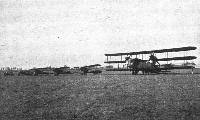
Flight, December 1919
THE PARIS AERO SHOW 1919
PRELIMINARY REPORT ON BRITISH SECTION
The British and Colonial Aeroplane Co., Ltd.
The Bristol "Babe"
In some respects, perhaps, the small single-seater sporting machine, which will be known as the Bristol "Babe," will have a wider appeal than any of the other Bristols exhibited, as it is a serious attempt to provide the small, compact, handy and inexpensive sporting aeroplane of the future. It is of quite diminutive dimensions, the overall length being 15 ft. and the wing span 19 ft. 8 ins. The machine does not, therefore, require a large shed for its housing, while its light weight enables it to be handled on the ground with ease by one man.
Ease of maintenance has been aimed at in the design by doing away with as much bracing as possible. Thus the fuselage is covered with three-ply wood, without bracing wires, and the tail is of the cantilever type, also without external bracing. The wings are of the usual type with lift and landing wires, running to the upper and lower ends of one set of Vee inter-plane struts on each side. The ailerons which are fitted to the top plane only, are of large area, running in fact right from the tip to the centre section. The power plant is a 40 h.p. two-cylindered Siddeley aircooled engine, which consumes about three gallons of petrol per hour at full throttle, when the speed of the machine is 80 m.p.h. At maximum speed, therefore, the machine does about 27 miles to the gallon, while at the economical cruising speed of 65 m.p.h. even greater economy is attained. The landing speed is as low as 40 m.p.h., which enables the machine to alight in and start from quite a small field.
Описание:
- Flight, December 1919
THE PARIS AERO SHOW 1919 - Flight, January 1920
The Paris Aero Show 1919
Фотографии
-
Air Enthusiast 1971-10 / Plane facts
The "Babe" was a diminutive biplane with A.B.C. engine (radial). 1920
The Bristol Babe Mk I with a 45 hp Viale engine flown on 28 November 1919. -
Flight 1919-12 / Flight
THE BRISTOL BABE: Photograph of the machine in skeleton form
-
Flight 1920-01 / Flight
The Bristol Baby
-
Flight 1920-02 / Flight
The two-cylindered air-cooled Siddeley 40 h.p. engine, installed in the Bristol Babe
-
Flight 1920-04 / Flight
The Bristol "family" at Home. Left to right: The Bristol Babe, the Bristol monoplane, the Bristol Badger, the Bristol Fighter, the Bristol Tourer and the Bristol Pullman triplane
Другие самолёты на фотографии: Bristol Braemar / Pullman - Великобритания - 1918Bristol F.2A/F.2B Fighter - Великобритания - 1916Bristol F.2C / Badger - Великобритания - 1919Bristol M.1A / M.1B / M.1C - Великобритания - 1916Bristol Tourer - Великобритания - 1919
-
Flight 1939-03 / Flight
The Bristol “family” of 1920. From left to right the types are the Tourer, the Scout type F, the Babe, the monoplane, and the “Brisfit.” Behind them all is the huge Pullman passenger-carrier.
Другие самолёты на фотографии: Bristol Braemar / Pullman - Великобритания - 1918Bristol F.2A/F.2B Fighter - Великобритания - 1916Bristol M.1A / M.1B / M.1C - Великобритания - 1916Bristol Scout E / F - Великобритания - 1918Bristol Tourer - Великобритания - 1919
-
Flight 1920-01 / Flight
THE BRISTOL BABE: Attachment of lower plane to foot of Vee struts
-
Flight 1919-12 / Flight
The Bristol Babe, 40 h.p. Siddeley engine
- Фотографии







